Damien Chazelle Breaks Down Babylon’s Sordid Hollywood History
Exclusive: Director Damien Chazelle explores the influences and inspirations for his epic vision of old Hollywood: Babylon.
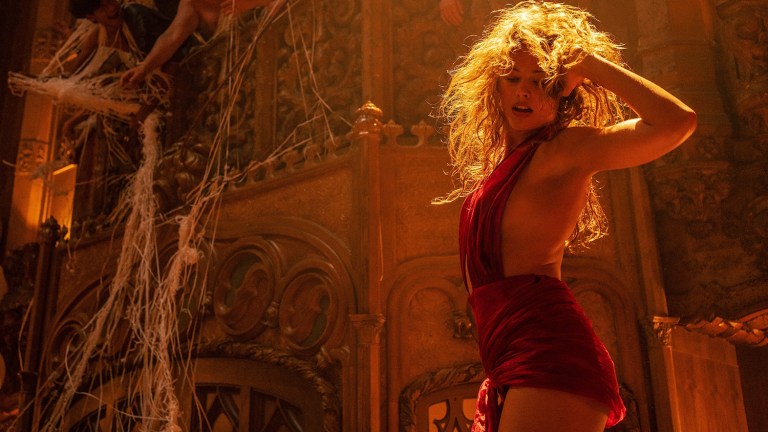
This article contains Babylon spoilers.
Despite the lurid imagery associated with Babylon, Damien Chazelle’s three-hour bacchanal of a movie about Golden Age Hollywood, it wasn’t wretched excess or decadence which first caught Chazelle’s imagination. Nor was it the glamor and gaudiness associated with a new (read: low) art form in those heady days when the silent era gave way to the earliest sound films.
Rather the inciting idea for Babylon is borne from a simple yet disturbing bit of trivia on the mortality rate in Los Angeles—and how the number of deaths seemingly caused by suicide rose precipitously during the late 1920s and early ‘30s. When looked at from afar, it would appear that the advent of The Jazz Singer (1927) and talkies invited not only musicals to Hollywood, but Death itself.
“It was actors, directors, people both in front of the camera and behind the camera, right around the time that sound was coming in,” Chazelle tells Den of Geek, “including some very famous people. Drug overdoses, [alcohol], and it’s unclear whether it was suicide or accidental.”
He adds, “The idea that a technological transition like that—which on the one hand might seem sort of trivial, you’re just adding one more color to the palette of cinema—something as simple as that could be that traumatic, that cataclysmic, and could really drive that many people to literal death, it sort of just grabbed my mind as the window into the rest of the movie.”
In this way, the filmmaker likens Babylon to a disaster film, a spectacle about “a wrecking ball hitting a fragile society still in its infancy, still figuring out its own parameters, and surveying the damage that wrecking ball causes.” It’s a curious insight into his own film’s genesis, and which feels a piece with the fuller, more challenging movie audiences discovered inside the theater. Babylon’s marketing promised a riotous party (and that is certainly on lascivious display), but the film is as concerned with the hangover; the ugly morning after for a community that still had one foot planted in the fantasy of the Old West and 19th century. Now they were forced to adapt to a more efficient, modern, and ostensibly “moral” sensibility. The fallout was tragic. And while the movie is a fictional parable, it’s drinking from a very real, often anguished history.
When we sat down with Damien Chazelle last month, we spoke at length about those real-world historical accounts, rumors, and legends that swung Babylon’s wrecking ball.
The Biggest Parties in Town
Babylon may spring from old Hollywood stories marred by hardship, but any sorrows were often punctuated by knock-down, drag-out revelries that would make Jay Gatsby blush. The film’s title is itself derived from the notorious sets built along Sunset Blvd. for D.W. Griffith’s most monumental in scope epic, Intolerance (1916), but it also knowingly touches on how Hollywood was viewed in the heartland during the 1920s: a modern day Sodom and Gomorrah.
German transplant director William Dieterle (1939’s The Hunchback of Notre Dame) arrived in Hollywood during the tail end of the silent era in the late 1920s. He’d go on to wistfully reminisce that in those days, “We all drank. My God, how we drank.”
Babylon enthusiastically embraces that image of merry debauchery with a scintillating first act that devotes about 30 minutes to the anticipation, enactment, and aftermath of the party from hell: a wild carnival of booze (despite occurring in 1926, and therefore during Prohibition), writhing naked bodies, and even an elephant.
According to Chazelle, that opening sequence was not based on any single Hollywood shindig but is instead a mixture of recollections and reports from various parties at the time.
“For instance, there’s an anecdote told by this writer Frederica Sagor Maas,” Chazelle says. “She reminisced very vividly about being at some Hollywood party that quickly descended into an orgy, involving everyone from Irving Thalberg to various other seemingly respectable people of society at that time, all of whom wound up just sort of fornicating on the floor at this party in plain sight.”
Sagor Mass was a playwright and brief screenwriter who is perhaps best known today for her memoirs of working in the early 20th century, including her eye-popping account of a party that occurred at the Ambassador Hotel in 1925. That hotel, for the record, also housed the famous Coconut Grove nightclub, which is where Joan Crawford (then named Lucille Fay LeSueur) hung around every night as a contract player, wearing gowns cut lower than the other girls and, like Margot Robbie’s Nellie LaRoy, getting potential male employers’ attentions by dominating the dance floor.
However, Sagor Mass’ memories of the Ambassador returned to a more exclusive dinner event where “with the dessert, a group of starlets, nightclub belly dancers, and ladies of the evening made their entrance. They were greeted by a halo of drunken delight, and room was made for them at the table, one girl to each unescorted male. Pretty soon, the men started disappearing with one or two girls, headed for the bungalows.” She saw MGM’s wunderkind Thalberg in the middle of this while being “drunk, drunk, drunk,” but that was less shocking than seeing her own supervisor chasing “shrieking” naked women across the dance floor.
Similarly, Chazelle pulled from the accounts of real Black jazz musicians who, like Jovan Adepo’s Sidney Palmer in Babylon, were hired to play the Hollywood party circuit during this era.
Says Chazelle, “I think it’s Les Hite who joked about how he wound up playing horn at one of these parties when he was just 18, and I forget his exact words, but he said, ‘I learned more about manhood and anatomy in one night than the rest of my life combined.’”
But even the most bracing early moment in Babylon hints at the darker side of Hollywood’s excess. Onscreen it comes when an unnamed contract player is encouraged to urinate on an unnamed heavyset star who likes being called “piggy.” By the end of the party, the young woman has overdosed on cocaine and the rotund actor is crying to his studio boss to save him. This has obvious roots in one of the most notorious scandals in Hollywood history.
“It’s a little earlier, but reading about the infamous Fatty Arbuckle kind of party in San Francisco, and in that case taking over this hotel and demolishing it, and of course someone winding up dead as a result [was an influence],” Chazelle says while alluding to the notorious events of Labor Day 1921. Over that long weekend, Arbuckle and his pals commandeered the St. Francis Hotel. There Arbuckle was alleged to have raped model Virgina Rappe, who died several days later due to a ruptured bladder and secondary peritonitis. While Arbuckle was eventually acquitted after three trials, it was the end of his career and also the first national scandal so insidious (and embellished in newspapers) that it helped begin cries for moral reform in Hollywood. The beginning of the end for Babylon.
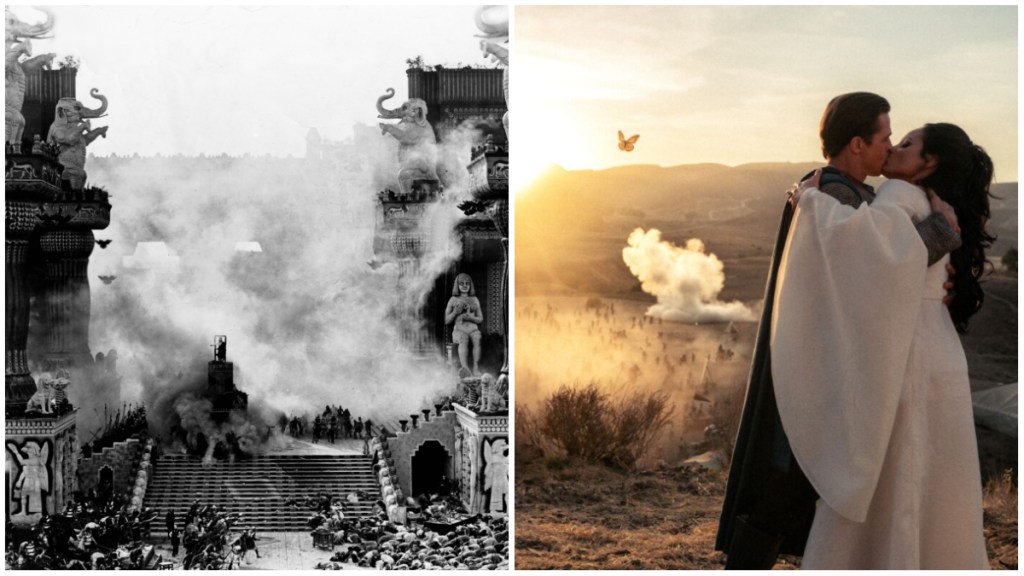
War Movies with an Actual Body Count
As much as Babylon revels in Golden Age Hollywood’s playtime, its greatest strength comes from how it depicts the industry at work. Just as the first half hour of the movie focuses on a party, the next half hour is just as concerned with how the sausage is made on two pictures, a tragicomic romance story that would go on to make Robbie’s Nellie LaRoy a movie star, and a nondescript “costume picture” starring Jack Conrad (Brad Pitt) that needs a massive battle sequence filmed in the California desert. In fact, the latter is such an impressively realistic battle that it leaves at least one crew member dead with a spear through his belly, providing a golden opportunity for Manny Torres (Diego Calva) to step up as a gopher on the production.
“There’s a lot of Intolerance in there,” says Chazelle, “but that’s about 10 years before the scene in [Babylon]. It’s also stories about shooting The Big Parade or Wings, or things like that. The epic battle scenes of that era.”
Chazelle citing The Big Parade (1925) and Wings (1927) is appropriate. The former was a World War I melodrama that starred John Gilbert (the primary inspiration for Pitt’s Jack Conrad) and the latter also was a WWI drama that starred Clara Bow (the main basis for Nellie LaRoy) and which became the first movie to win a Best Picture Oscar. Nonetheless, the sequence feels most inspired by Intolerance, not least of all because it was (partially) an ancient period piece with battle scenes that had an actual body count!
As Chazelle tells it, the memories of Joseph Henabery, an assistant director to Griffith on Intolerance (1916), proved invaluable for shaping one of Babylon’s best sequences: Manny Torres “negotiating” with the extras.
“He’s walking down the road one day, and he’s walking by this pen, and you think it’s a pig pen… but it’s a pen for actors, which is sort of how they thought of them in those days,” Chazelle explains. “And he saw these people who were getting mussed up for a role for a movie, and someone comes and sees him through the grates and says, ‘Hey you, you want to work here?!’ And Joe Henabery’s penniless, so he’s like ‘yeah, sure.’ And they hoist him onto the set, and it turns out they’re shooting one of the battle scenes of Intolerance out in the middle of nowhere. And they shipped in the warriors for this day of shooting, the thousand-plus extras they amassed are all junkies they found on Skid Row, and they just offered a lunch for the day.”
Chazelle continues, “So they’ve got these junkies there, and the junkies decide on the spur of the moment that they don’t feel like working that day, and they realize they’ve got some power in numbers. So Joseph Henabery is sort of thrust in to deal with it, and that’s where Manny’s first encounter comes from.”
Like Manny in the movie, Henabery said he wound up getting on a horse and firing a gun and shouting, “I’ll shoot you in the fucking face if you don’t work!” It made for a great battle sequence, but not for a great day’s work for those costumed and told to run at each other with weapons since an undisclosed number of folks are reported to have died while filming the sequence (Hollywood wouldn’t start counting fatalities publicly until three people drowned while filming Noah’s Ark in 1928).
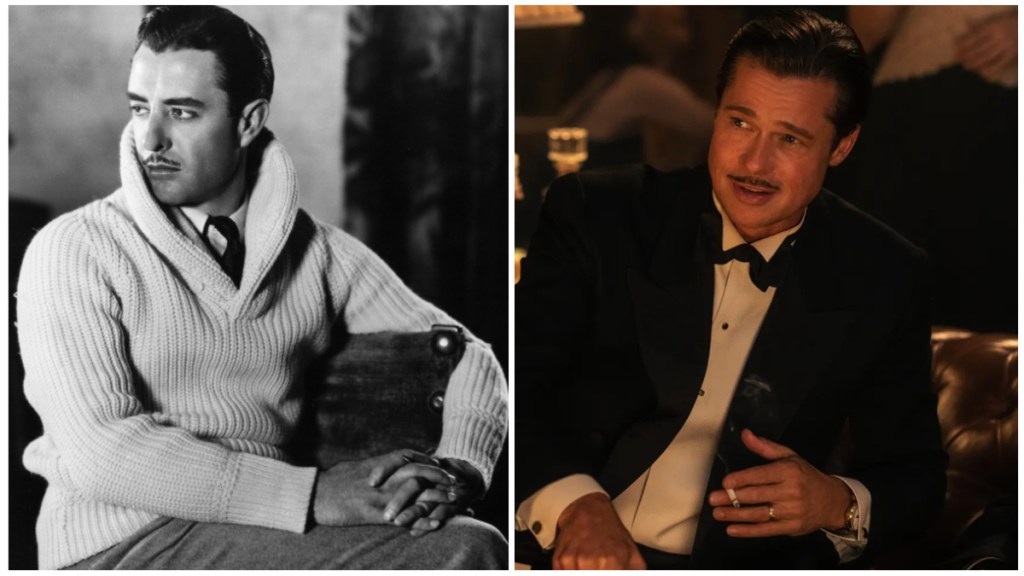
Brad Pitt’s Jack Conrad
Perhaps the most tragic figure in Babylon is Pitt’s Jack Conrad, a movie star of a certain age who is desperate to see the industry innovate during the height of his popularity in 1926, yet is left heartbroken when that innovation pivots toward sound and audiences snicker at his voice. He winds up a forgotten relic of the silent era… and a victim of suicide in 1932.
It does not take much squinting to see the sad story of John Gilbert (Jack to his friends) in Pitt’s Conrad. Like the Pitt character, Gilbert was on top of the world in 1926 after starring in the previous year’s The Big Parade and The Merry Widow, and before that he had achieved notoriety with audiences, particularly female patrons, for being the decade’s greatest silent lover this side of Rudolph Valentino. However, after the talkies came in, his stilted delivery and seemingly “high-pitched” (read: effeminate) voice in His Glorious Night (1929) caused audiences to spontaneously guffaw. It was all downhill from there until his death in 1936, which was brought on by two heart attacks and years at the bottom of a bottle.
Before the star’s death, director Dieterle lamented, “Gilbert sits on his palazzo on top of the mountain. He still looks wonderful. He’s only 35 years old. All the talent’s still there, the wit, the intellect, but it’s like a spell has been cast. Those last bad years at MGM destroyed something in the center of him… You look at this handsome guy with all the parts still together, it was unbelievable what happened to him.”
Yet there is plenty of debate over just why Gilbert’s voice made him a punchline. Did he naturally have a high-pitched voice or was he given bad direction by MGM, which trained him to speak in correct stage diction? It’s worth considering there’s a famous story about Gilbert punching out MGM mogul Louis B. Mayer on the day Greta Garbo stood Gilbert up at the altar, making an enemy for life out of his employer. And was Gilbert’s career so unsalvageable that after he returned from a two-month honeymoon in Europe with Ina Claire—his third wife, who like Conrad’s fourth bride in Babylon came from New York’s more respected theatrical circles—his career was already effectively over because of the release of His Glorious Night?
Whether it was the voice, a vengeful studio boss, or something more intangible, there is an argument posed by Babylon that when your time in the industry is up, it’s up.
Says Chazelle, “That to me is the more interesting version of the story, as opposed to someone where you could see a mile away that they’re not going to survive into sound because of a high-pitched voice or squeaky voice or whatever. The version of Gilbert, which is the version I believe a little more if you look at his sound films—he doesn’t sound that bad to me—it’s something subtler and more insidious than that. It’s not as simple as just he opened his mouth and some kind of very comically bad voice came out. Gilbert has this beautiful quote where he says, ‘It’s not that I had a bad voice, it’s that I had a voice.’”
As Chazelle sees it, “People have fallen in love with a sort of romantic screen idol, and they don’t even realize, and the actor doesn’t realize, the extent of that that’s wrapped up in the voicelessness. It’s wrapped up in the language of silent cinema, so that as soon as he opens his mouth, even if he is a good deliverer of dialogue, it almost doesn’t matter. It bears a spell that’s broken.”
Indeed, while Gilbert’s first talkie in 1929 wasn’t actually the end of his career, his waning days at MGM were so publicly toxic and volatile that he was let out of his contract early after complaining in the press. It didn’t help him, even though the arguable love of his life, Greta Garbo, tried to get him more work via her own successful talkies. By the mid-1930s, Gilbert’s continental airs were replaced by the likes of Clark Gable, a masculine presence who would say aloud that he doesn’t give a damn about the woman he loves.
Still, unlike Pitt’s Conrad, Gilbert didn’t (technically) commit suicide. For that, Chazelle points us to another actor who almost became a star in the mid-1920s before the talkies came along.
“In terms of his actual death, it was a little more Karl Dane, who I may have read about through reading about John Gilbert because they overlapped,” says Chazelle. “They were in The Big Parade together, but Karl Dane is an example of someone who took the more violent, brutal way out when his career didn’t transition successfully.”
That death occurred in 1934 when after a failed attempt at becoming a restaurateur, Dane was seeking work as a carpenter or extra at MGM and Paramount. Then in April he was pickpocketed with the thief stealing the last $18 Dane had to his name. The former actor thus went home to his apartment, looked at a scrapbook filled with photos, reviews, and contracts from his film career, and proceeded to put a bullet in his skull.
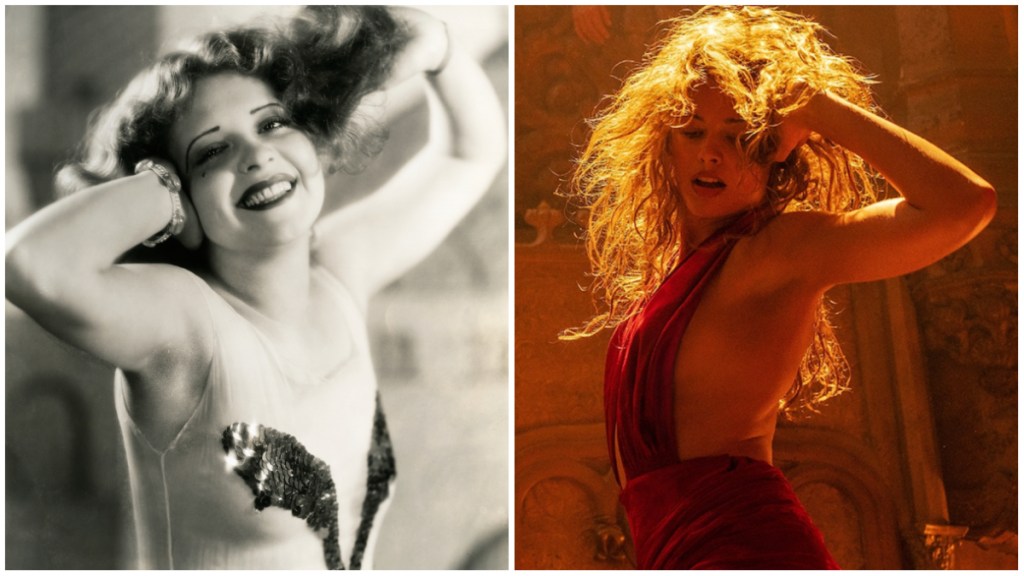
Margot Robbie’s Nellie LaRoy
Jack Conrad may provide the broadest tragedy in Babylon, but its fiery soul comes from Nellie LaRoy, the rabble-rousing idol of the Jazz Age in Hollywood. One doesn’t have to look too hard either to recognize the literal first It Girl in Nellie’s swaggering dance moves: She’s Clara Bow in all but name.
Born in Brooklyn (as opposed to New Jersey like Nellie), the real-life Clara came from a horrible childhood only hinted at in Babylon. Her mother, who suffered from epilepsy, attempted to murder Clara with a knife when the daughter was only age 17. Afterward, her mother was institutionalized (as seen in Babylon, although the real Sarah Frances Bow died a year after being locked away). Later in life, Bow also underwent psychotherapy which helped her find repressed memories of her father raping her repeatedly after her mother was gone—an evil only vaguely hinted at in the uncomfortable fury Robbie’s Nellie feels whenever sharing a scene with her father Robert Roy (Eric Roberts).
Today Clara is primarily remembered as the definitive onscreen flapper of the Roaring ‘20s who starred in the frothy It (1927), the movie that made her a megastar and invented the term “It Girl.” There’s a lot of innuendo and inaccuracies about her legend too, from salacious stories of her sleeping with the entire USC football team, including a young John Wayne (Bow liked partying with them as seen in Babylon but considered them boys) to the conventional wisdom that her stardom waned in the 1930s because of her Brooklyn accent.
“You can kind of see the seeds of the problem early on, but the problem is deeper than just a voice,” Chazelle argues. “It’s actually much more to do with this whole sort of social changes that were ushered in around this time, either having to do with sound or independent of sound, but certainly concurrent, which was this sort of move from a kind of free spirit, celebrating sexual liberation of a certain kind into a much more puritanical, moral clause-driven culture. It’s also pre-Code to Code as well.”
He adds, “You stop seeing sex symbols of the kind like Clara Bow or Nellie LaRoy once you go into the ‘30s outside of certain anomalies, Jean Harlow for example. You really stop seeing that sort of actor where the entire point of their persona is this kind of game that they’re promiscuous as hell, that they’re gonna grab society by the lapels forcefully and shock it and shake the foundations.”
With that said, the real Bow did struggle mightily transitioning to sound, and the standout sequence in Babylon where Nellie’s first talkie descends into a Kafkaesque nightmare where the whole set is beholden to the sound booth is based on Bow’s first talkie troubles on The Wild Party (1929). Reportedly, Bow blew the mic valve when she screeched, “Hello, everybody!” on her first take. That shoot likewise collapsed into chaos as Bow became increasingly nervous and agitated with the constrictions sound placed on her acting.
Still, Bow did have hits for Paramount into the early ‘30s, but as the Depression came in, her free-spirited ways—such as dismissing movie star Gary Cooper as having “the biggest cock in Hollywood and no ass to push it with” after he decided against marrying her—fell out of favor with her studio. Following a publicity scandal involving a former assistant attempting to blackmail her, Bow checked herself into a sanatorium instead of showing up for work on The Secret Call. Once there, she was diagnosed with “shattered nerves.” In retaliation, Paramount released her early from her contract.
Bow made several more films at Fox afterward, but largely left Hollywood to live on a ranch with her husband Rex Bell for the next 30 years. It’s a quieter ending, and not nearly as apocalyptic or ambiguous as that of Nellie LaRoy’s fate.
“I definitely think the downfall of Nellie is one of the areas where it deviates from Clara Bow’s story quite a bit,” says Chazelle. “There’s a way in which Clara Bow ultimately took things into her own hands and deliberately left Hollywood and started a new life. Now if she hadn’t done that, maybe she would’ve ended up like Nellie does in the movie. Maybe she really would have met a dark end.”
Still, Chazelle notes that he also based Nellie’s tragedy on a handful of other Hollywood stars and starlets who were not so lucky during the late 1920s and early ‘30s, specifically naming Jeanne Eagels and Alma Rubens, neither of whom lived to see the age of 40 despite rising to stardom during the silent era. The former became addicted to heroin and the latter cocaine, and both died of complications thereafter. Meanwhile Thelma Todd, most famous now for having starred in Marx Brothers comedies like Monkey Business (1931) and Horse Feathers (1932), was found dead in her automobile with the engine running and the garage shut. The LAPD ruled it an accident, suggesting she was intoxicated and didn’t know she was killing herself, but conspiracy theorists point out the night she died she also had tense words at a Hollywood party with her ex-husband, agent Pat DiCicco, who had connections to the mafia and Lucky Luciano.
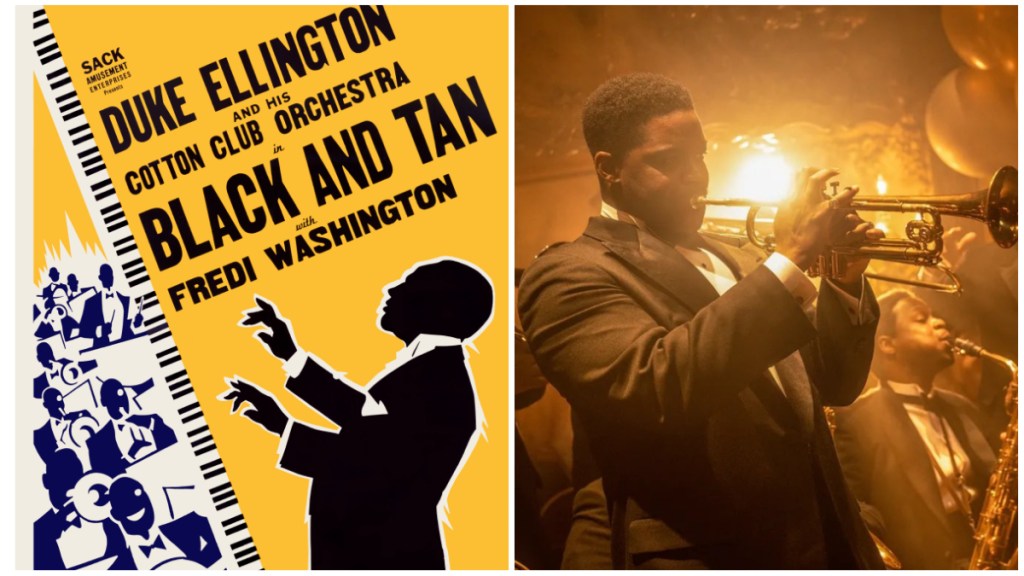
Jovan Adepo’s Sidney Palmer
One of the few figures who actually perseveres and seems happy with his life choices by the end of Babylon is Adepo’s Sidney Palmer, a Black horn player who has a brief flirtation with movie stardom by Hollywood’s standards circa the early 1930s (i.e. blackface), and then frees himself from the system by returning to playing on the Central Avenue circuit in Los Angeles. He’s less rich but certainly a lot happier than Jack or Nellie. He’s also not based on a single primary historical personage like those characters.
“In trying to construct Sidney Palmer’s character, I was looking at some of the jazz musicians of the time,” Chazelle says. “Not the big kahunas, the Duke Ellingtons, but more the people who were working musicians, who for instance worked the Central Avenue clubs sometimes, and other times worked the Hollywood party circuit. Some of them had stories or reminiscences.”
Chazelle was also taken with that moment during the transition to sound when Hollywood briefly let Black musicians lead shorts and a handful of features.
Says the director, “What’s also sad and poignant about it is how fleeting this moment was between like 1929 and 1930, and almost not beyond, where partly because of their desperation to harness this thing called sound, and get more audiences into the theaters, Hollywood studios started reaching directly into the Central Avenue community, the African American community in Los Angeles, and started making deliberately Black films.
“It was different from what had been going on before. Obviously Oscar Micheaux was making films with Black casts way before this, but now suddenly for a fleeting moment, it was Hollywood studios who were just obsessed with it. That’s how you get both a string of really interesting short films, these sort of one-reelers led by people like Duke Ellington or Ethel Waters, or Bessie Smith. They’re almost music videos before music videos. There’s a little narrative, a little dialogue, mostly given over to music, but also you got a few features. You got movies like Hallelujah and Hearts of Dixie [in 1929].”
Nonetheless, the most shocking and despairing moment in Chazelle’s movie—where Manny forces Sidney to wear blackface so his lighter skinned complexion would read as definitely Black to racist theater owners in the South—is also based on real accounts from a film in the Amos ’n Andy franchise, which began in the 1920s with two white men pretending to be Black on radio before transitioning to full-on blackface onscreen.
“This happened multiple times,” says Chazelle. “I wouldn’t say it was exactly the norm, but it had happened enough for it to be noteworthy. The first time I read about it is this Amos and Andy movie, ironically, called Check and Double Check, 1930, where the Duke Ellington Orchestra, or the Juan Tizol wing of the Duke Ellington Orchestra, was playing. It was an all African American band, but two of the musicians were instructed to put cork on their face for the same reasons delivered in the film: Certain theater chains would otherwise not exhibit it if it looked like an interracial band.”
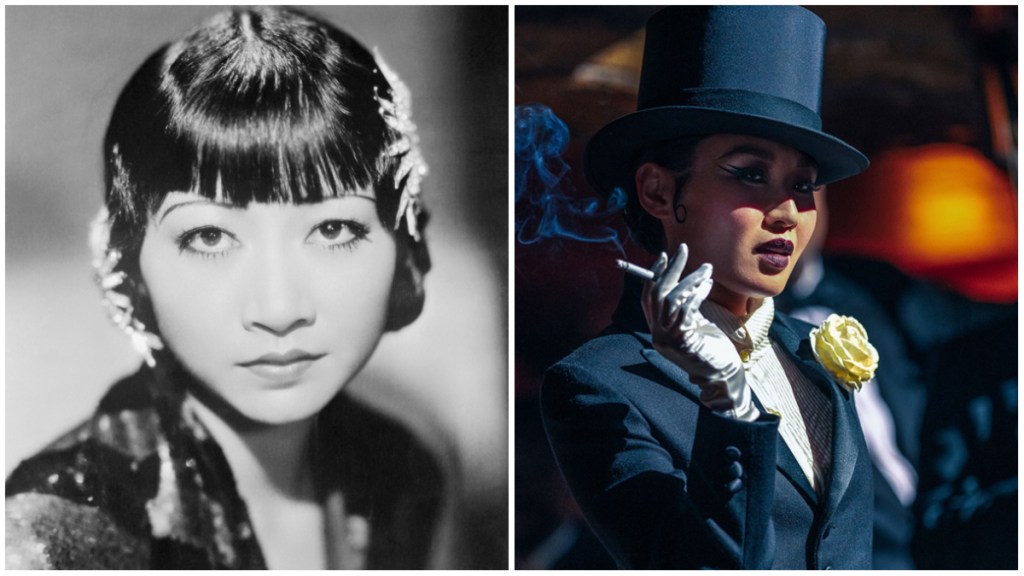
Li Jun Li’s Lady Fay Zhu
Li Jun Li’s Lady Fay is one of the more elusive and poignant presences in Babylon. Introduced as wearing a tuxedo and openly singing about her liaisons with other women, she’s a bracing presence for viewers with perhaps simpler notions about “olden days.” She also is suggested to be both an onscreen star of “exotic” allure to white 1920s audiences, as well as a behind-the-scenes player who wrote the title cards for many silent films, including the “The Wild Child,” basically Nellie LaRoy’s It.
On the surface, Fay is obviously based on Anna May Wong, the first Asian-American movie star whose career was a trajectory of thwarted and squandered talent. However, there are more than a few other influences on a character who’s depicted as openly romancing it girl Nellie on the dance floor at a party, and later gossiped about in the press for (accurately) carrying on a romance with the famous white movie star.
Like Fay, Wong was born the daughter of second-generation Chinese-Americans who owned a laundry in Los Angeles. During the early years of her career in the 1920s, she really did live above a laundry while starring in films like Bits of Life (1921) and The Toll of the Sea (1922). The latter was a Madame Butterfly update with Wong playing the Chinese lover of an American airman who crashes into the sea. She saves his life but despite them being married by “Chinese custom,” the white man eventually leaves her for a white woman. Wong would continue to be exoticized throughout her career, but after the morality clauses came in at the end of the ‘20s, and then the Hays Code in the 1930s, she would be denied roles where she could even have relationships with leading men due to the Code banning all interracial kissing. This effectively relegated Wong to supporting, villainous roles as “the Dragon Lady,” the first of which occurred in the Douglas Fairbanks-starring The Thief of Baghdad (1924).
“I think in many ways it made things worse for anyone who wasn’t white at the time,” Chazelle says of the brand of moral conservatism that swept Hollywood in the 1930s. “There was a way in which sound coming in weeded out accents of all stripes, and then moral codes coming in weeded out a certain kind of allowance, for instance, different sorts of sexual behavior onscreen or off-screen.”
It’s not known whether the real-life Wong definitely pursued same sex relationships with other women—although it’s long been speculated that she was part of Hollywood’s fabled “sewing circle.” But like Lady Fay, Wong briefly left Hollywood in 1928 for roles in European cinema before fascist politics made that untenable. Ironically, in her time in Europe she increased her already existing friendship with Marlene Dietrich, a German star who barely hid her habit of pursuing men and women both as lovers, as well as future Nazi propagandist Leni Riefenstahl (who is rumored to have had affairs with Dietrich before the rise of the Nazis eventually severed that relationship). Dietrich also often wore a tuxedo and top hat like Lady Fay does at the beginning of Babylon.
Chazelle admits he combined Wong and Dietrich to create Lady Fay and notes, “Of course Marlene Dietrich did manage to thrive in the sound era, but there is a way in which the runway got narrower for a time, and I’d argue you have to jump ahead to the ‘60s to see things loosen up in that way again.” The director also concedes the relationship between Fay and Nellie in Babylon is based on the rumors around Wong and Dietrich (or perhaps a number of other Golden Age Hollywood stars and their roommates).
“It’s just such a delicious rumor, and maybe true,” says Chazelle. “Maybe even seeing photos of them together, there’s just something [to it]. I sort of want them to have been a couple… but Anna May Wong would do some of the crossdressing in male sort of suits, that spoke to a kind of freedom of expression that existed at that moment that got stamped out pretty quickly thereafter. The scene itself [between Fay and Nellie] was sparked most of all by a short little dance in Pandora’s Box with Louise Brooks and the [Daisy D’Ora]. They have this suggestive dance scene amidst an otherwise very heterosexual party, and that was kind of the spark of it as well.”
Chazelle also points out that he combined other elements into Fay’s background. As likewise seen with Olivia Hamilton’s fictional 1920s Hollywood director in Babylon (but who appears partly based on Dorothy Arzner), the silent era provided a greater opportunity for women to direct and write films than the more industrialized (and patriarchal) 1930s.
“The other thing with Anna May Wong that’s interesting is that there was this sort of wearing multiple hats,” Chazelle says. “And certainly she’d do very different types of performance, but I liked the idea as well that maybe melding her as a historical character with someone like [screenwriter] Frances Marion, or someone who’s writing title cards behind the scenes, basically screenwriting before you even called it screenwriting.”
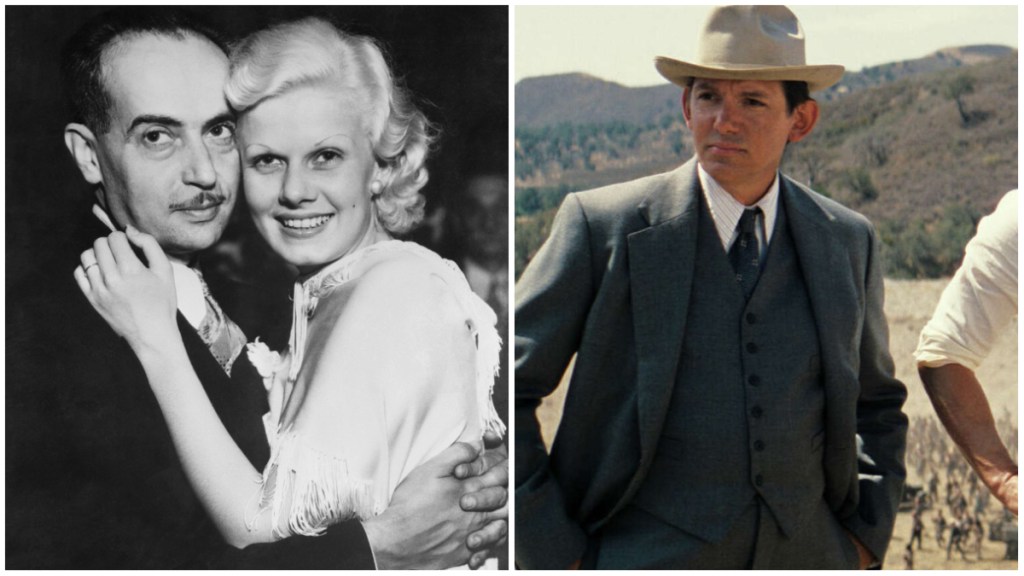
Lukas Haas’ George Munn
Going back to Chazelle’s inciting idea about the era being notorious for its suicides, or seeming suicides, there also remains one of the more amusing peripheral characters in Babylon who’s based on perhaps the most infamous death in early Hollywood history: MGM big shot Paul Bern.
In the movie, Paul Bern is renamed George Munn and played by Lukas Haas. He’s the MGM producer who is also Jack Conrad’s friend and most loyal booster. On a film set, he’s great at solving problems and covering up deaths, but in his down time he’s a sad sack so pathetic that Jack has to convince Fay Zhu to talk him up or he’ll wind up with his head in a toilet.
“It may be apocryphal, but a famous Paul Bern story is him trying to kill himself by drowning himself in a toilet, then changing his mind and carrying a toilet seat around his neck the rest of the party,” says Chazelle. “The sort of continual suicide attempts and kind of unlucky in love thing Paul Bern had. Yet at the same time being this really big deal movie producer, this paradox of him, and of course him winding up dead, murdered? Who knows?”
Indeed, the real-life Bern was one of those apparent suicides that occurred after the talkies came in, with the producer dying in September 1932, two months after marrying the first blonde bombshell, Jean Harlow (she literally starred in a movie called Bombshell in 1933!). Despite that marriage, Bern remained unhappy and their marriage was allegedly never consummated. (Depending who you ask, Bern was either gay or sexually impotent). Then over Labor Day weekend 1932, his body was found with a bullet in his head, a .38 revolver in his hand, and a letter nearby that read:
“Dearest Dear,
Unfortunately, this is the only way to make good the frightful wrong I have done you and to wipe out my abject humiliation. I Love you.
Paul
You understand that last night was only a comedy.”
The note is almost sweet. It’s also arguably suspicious since MGM’s crisis management team discovered it in a closed guestbook out of reach from the body. It was also learned by the press days later that Bern was a bigamist with a common law wife who a few weeks after his death was discovered to have (maybe) fallen from a boat and drowned.
For the purposes of Babylon, George Munn killed himself. But as the whole movie screams in hand-stenciled color, the reality was often a lot darker and stranger than what’s up on the screen.
Babylon is in theaters now.
